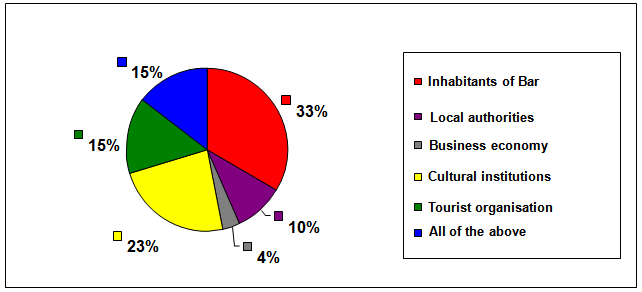-
Paper Information
- Next Paper
- Previous Paper
- Paper Submission
-
Journal Information
- About This Journal
- Editorial Board
- Current Issue
- Archive
- Author Guidelines
- Contact Us
American Journal of Tourism Management
p-ISSN: 2326-0637 e-ISSN: 2326-0645
2014; 3(1B): 20-25
doi:10.5923/s.tourism.201402.03
Multicultural History of the City of Bar (Montenegro) as a Basis of Development of Cultural Tourism – Attitudes of Tourism Workers
Srđan Milošević, Vaso Jegdić, Iva Škrbić
Educons University, Faculty of Sport and Tourism, Radnička 30a, Novi Sad, Serbia
Correspondence to: Srđan Milošević, Educons University, Faculty of Sport and Tourism, Radnička 30a, Novi Sad, Serbia.
| Email: |  |
Copyright © 2014 Scientific & Academic Publishing. All Rights Reserved.
Cultural tourism has been recognised in many countries as a chance for economic and overall development. The area of the city of Bar, connecting the Balkan inland and the Adriatic coast, is a rich treasury of cultural monuments from different historical periods, ranging from pre-history and the antique to middle ages and our times. Among them are the Eastern Orthodox and Roman Catholic monasteries and churches, monuments of Muslim culture, fortresses, etc. Their protection, studying, presentation and popularisation should become a priority, in order to include this rich cultural legacy in the tourist offer, but also to preserve it for posterity. The paper researches the attitudes of workers in the sectors of tourism and culture as well as that of the agents of local development on the potentials and possibilities of implementation of cultural resources in the tourist offer of the city of Bar. A field research was conducted using the method of descriptive statistics, with the data collected by means of survey.
Keywords: Bar, Cultural tourism, Multicultural legacy, Cultural identity, Local community
Cite this paper: Srđan Milošević, Vaso Jegdić, Iva Škrbić, Multicultural History of the City of Bar (Montenegro) as a Basis of Development of Cultural Tourism – Attitudes of Tourism Workers, American Journal of Tourism Management, Vol. 3 No. 1B, 2014, pp. 20-25. doi: 10.5923/s.tourism.201402.03.
Article Outline
1. Introduction
- Lately, when all advantages of tourism have become apparent, particularly the economic ones, many places have begun to use cultural attractions to attract tourists. The advantage of cultural tourist movements also lies in their equal monthly share (Galdini, 2007). The equal monthly share of tourist turnover also reflects favourably on the use of service capacities (Stanciulescu, 2008), thus also on the effects of the entire tourism economy. The reason for such a great interest in cultural goods is partly a consequence of globalisation and the wish to learn about the cultures of various peoples. Cultural goods (moveable and unmoveable) are witnesses to an identity of a nation and the people who previously inhabited a certain area (Hadžić, 2005). The meaning of this learning has the deepest sense if one visits the localities in which these goods are located. It is certain that the impressions on cultural goods are different when seen at a museum and at the place where they were created.Bar with its inland area belongs to the Balkan Peninsula. During its history, the Balkans were perceived as a bridge between the east and the west. The Balkan discourse is that of similarities and differences, simultaneously, according to Catherine Fleming (2001). The areas in which different cultures converged and permeated can be of particular interest for tourists, due to their multicultural legacy and the specific spirit in which they function (Maksin-Micić, 2008). Simultaneous distance from Europe, but also its vicinity, creates the impression of a “stranger within”, some sort of intimate alienation (Jovanović, 2008). Its multi-ethnic and multi-confessional character, expressed through the feeling of interfusion, incompleteness, ambiguity, amorphousness and racial hybridisation (Živković, 2001) is a special challenge for tourism workers when promoting and presenting its cultural legacy in tourism.The area of the Bar municipality lies in the south of Montenegro, between the Adriatic Sea and the Skadar lake. The geodesic distance from the city of Bar to the Strait of Otranto is only 180 km and it is connected in a shorter and more direct way with all harbours on the shores of the Adriatic Sea than any other port on the Balkan side of the Adriatic coast (www.visitbar.org). After the main road and the Belgrade-Bar railway have been built, the traffic connections with the inland Balkan cities, Belgrade and the Danube have been strengthened. Via the port and the airport in Podgorica, the area has become accessible to the more distant tourist ‘emission’ countries, as well.
2. The Multicultural Legacy of Bar
- The area of the municipality of bar is a rich treasury of cultural goods that testify of its rich cultural and historical past, where different cultural currents from the broader area of the Balkan peninsula often permeated one another. The historical sources mention this settlement for the first time in the IX century, under the Greek name of Antibareos (Roman Antibarum, and Slavic Bar). Objects found there indicate that the area was been inhabited as early as the prehistoric period. Although inhabited by the Slavs as early as the VII century, Bar was ruled by the Byzantine empire until the middle of the XI century. It was ravaged, for a long time, by continuous wars and plunders of the local lords. Constantly changing hands between Duklja - the first Montenegrin state, Raška – the Serbian state, Byzantium, Venice and the Republic of Dubrovnik, then shortly ruled by Bosnian rulers, reconquered by Venice and, lastly, the Turks, who ruled it from the XVI century until the independence of Montenegro was declared in 1878.Among the most important persons in the earliest period of the city of Bar, prince Vladimir is mentioned, as the first independent ruler of the principality of Duklja or Dioclea (980-1016). The appearance of the prince Vladimir, who was later beatified, is also interesting because of the fact that the cult of St. Vladimir of Dioclea has been preserved to this day. The June procession to the summit of the Rumija mountain, which is popularly held to have once been the site of the church of St. Vladimir, is taken part in by the believers of all three confessions – the Eastern Orthodox and Roman Catholic Christians, but also the Muslims. The multi-cultural and multi-confessional character of Bar is also underlined by the current structure of its inhabitants. The most numerous are the Montenegrins, Serbs, Muslims, Bosniaks, Albanians and Croats (RZSCG, 2004). Different cultural currents and influences on the border of east and west have left a visible mark in that area, which was recorded in the spiritual and material culture (Kasalica, 2009). These influences and traces are witnesses to the fact that the dominant patterns of the once-ruling foreign cultures were not blindly followed (Rome, Byzantium, Islam, Venice) (Kasalica, 2000). It was here that the famous “Gesta Regum Sclavorum” (Genealogy of Bar) was written in the XII century – the chronicle of medieval Slavic lands and rulers in the Balkans (Mijušković, 1967).The area of the municipality of Bar is a home to the 32 registered, protected and categorised monuments of culture among which there are exceptional works of art, such as the monastery complexes, churches, fortresses, etc (Kasalica, 2000). The greatest number of cultural monuments is related to the Slavic cultural stratum, especially those from the eras of rule of the Vojislavljević, Nemanjić, Balšić, Crnojević and Petrović dynasties (Zagarčanin, 2001). The monasteries there are founded within the time span of 13 centuries. The most important among them, are the monasteries of Starčevo, Beška and Moračnik, as the foundations of the Balšić princes of the Zeta region in the area of the Skadar Lake, as well as the Prečista Krajinska monastery, the once-seat of the Zeta metropolitan. There are also ruins of the Ratačka Virgin Benedictine monastery, the size of which still remains impressive (Ratković, 1989). In the area of the municipality of Bar, there are a great number of Orthodox and Catholic Church temples, the oldest of which date from the VI century. Also, a very significant group of monuments consists of old urban agglomerations and fortifications. The most significant among them is the city of Bar (monument of the first category), which represents the largest ruined urban agglomeration in Montenegro (Peročević, 2000). The exceptional significance of the old city of Bar lies in the mixture of diverse styles visible in individual buildings, such as the Romanic, Gothic and Renaissance edifices, while in the era of the Ottoman Empire, the medieval city obtained some eastern traits (www.panacomp.net/crna_gora?s=stari_bar). Among the most significant monuments of Islamic architecture, there are the Omerbašića mosque in the Old Bar and aqueduct, which is the only object of such kind in Montenegro (www.visitbar.org). During all those changes of civilisations, states and rulers, peoples have left traces of material culture, some of which have perished in wars and earthquakes, but many have remained to this day, often in ruins, as monuments of culture and testimonies of rich and tumultuous past of the Bar area. The presence of such a diverse and numerous monument fund, which complements a rich spiritual legacy of diverse ethnic communities in this area, speaks much of a unique blend of cultures. Thus, the municipality of Bar, besides the nautical and seaside tourism, should direct the development of the tourist capacities towards the programmes with cultural content, as well (Dašić, Jovičić, 2011). Nature and culture are complementary and cultural recognition of a community is related to the natural environment in which it (had) developed (Petrić, Mikulić, (2009).
3. Cultural Tourism as a New and Complementary form of the Tourist Offer
- The subject of research in this paper are attitudes and observations of experts in the field of tourism, of workers in tourism, workers in culture and agents of local development in the municipality of Bar on potentials and possibilities for the implementation of cultural legacy in the tourist offer of Bar that would, as such, form an indispensable part of the tourist offer. Cultural tourism would thus be marketed as a new form of tourist movement and could develop according to all principles of sustainable development, forming a complementary tourist offer. Experts in the field of tourism are those people employed in tourism or complementary fields, related to tourism, competent for this research. From the public and the non-profit sector, the surveyees were the employees of the local self-government, dealing, among other things, with the matters of tourism and culture, then the workers in the tourist industry, tourist info centres, Cultural centre of Bar, the museums, galleries and cultural institutions, while those surveyees from the profit sector were employed in tourist agencies, hotels and entrepreneurial sector. The goal of the research was to examine the attitudes of tourism and culture workers about the possibilities, directions or limitations in a more active inclusion of the multi-cultural legacy in the tourist offer of the destination of Bar, which is otherwise a typical maritime tourist region. The purpose of the research was to employ the attitudes obtained through the research to find a concept through which the cultural tourism would be presented as a new and complementary form of the tourist offer of the city of Bar.The basic research was conducted by the means of a statistical method. In order to gather data, a technique of survey was used. Data was processed by using adequate statistical procedures. The sample of surveyees is intentional/controlled, seeing as the participants were chosen according to a previously defined set of criteria. Those criteria are related to a direct contact of surveyees with the visitors, as well as in the connectedness of the surveyees with the protection of cultural heritage, creation and promotion of the tourist offer of the municipality of Bar.The sample consisted of 85 participants, four of which were not considered due to irregularities. The character of the sample is representative, because it meets the basic criterion, which is to represent the part of the population that possesses the important traits of that population and can thus be used to obtain representative data. The very organisation of research was conducted in such a way that the surveyees completed the questionnaires themselves. The aim of the conducted research was to include the cultural resources in the tourist offer of Bar through concrete activities that should be implemented in developing the products of cultural tourism.
4. Implementation of Cultural Legacy in the Tourist Offer
- Out of 81 surveyee, 32 are men, 49 women. They belong to all age groups, with the young groups being dominant. As many as 33% of surveyees belong to the 20-30 age group, 25% of participants to the age groups of 31 to 40 and 41 to 50 years of age. More than a half of the surveyees, 53%, have graduated from a university, 17% have graduated from college, 17% have vocational secondary education and 10% have graduated from lyceums of a general type. The basis for the development of a form of tourism lies in the existence of attractive resources at a destination, in this case a cultural one. The perception of their importance by tourism workers is also very important, thus the research was initiated by looking for the answer to that question.When it comes to the cultural legacy of Bar, it is undeniable that it is a rich treasury of testimonies to the past centuries. The results of the survey indicate that the workers in tourism and complementary fields are aware of that fact, because as many as 97% of surveyees agree that the cultural legacy has a significant potential to aid the development of cultural tourism.
 | Graph 1. The cultural legacy of Bar underlies its important potential for the development of cultural tourism |
 | Graph 2. Cultural tourism can contribute to the preservation of tradition and customs of this area |
 | Graph 3. I like the idea about the development of cultural tourism and I support it |
 | Graph 4. I would be glad to take a part in the development of cultural tourism in the municipality of Bar |
 | Graph 5. Development of cultural tourism in Bar should rely on |
 | Graph 6. According to your opinion, cultural tourism should |
 | Graph 7. Who should in your opinion, be included in planning of cultural tourism |
5. Resources and Enviroment Necessary for the Development of Cultural Tourism
- Based on the results obtained through the research, it can be concluded that the municipality of Bar possesses cultural resources, as well as the ambient for the development of cultural tourism and that cultural tourism is possible in this area. Taking into account the attitudes of the participants, it is necessary to undertake certain activities in order to include cultural tourism in the tourist offer of the city of Bar. Tourism in Bar must be based on local attractions and must be authentic, in addition to being economically sustainable and contribute to the development of the local communities. The importance of research is reflected in the readiness of the people who work in tourism, cultural institutions, local self-government and similar organisations to recognise the chance for the development of tourism and to get acquainted with the effect it entails, on the basis of the existing resources. Also, the results indicate that there has to be a broad range of partnerships between the government, local community and all subjects in cultural tourism and that it is of great importance in order to better use the cultural potential and eliminate the possible negative influences. The surveyees have recognised that the development of cultural tourism in Bar should rely on the promotion of cultural goods. As indicated by the results of the research, the inhabitants of the municipality of Bar must control the development of tourism by setting goals, identifying resources and formulating a development strategy. Also, the inhabitants of Bar are responsible for the realisation of projects of cultural tourism, as well as for the development of the overall tourist infrastructure. Certainly, the development of cultural tourism enables the inhabitants a quality employment, which is an indispensable part of tourist development on a local level. In a certain sense, all inhabitants of Bar should profit from the development of cultural tourism. The very concept of development of cultural tourism needs to be such that the cultural goods remain preserved in accordance with the internationally acclaimed standards and criteria. The perception of cultural tourism needs to be authentic and local community should contribute to it, as well, reflecting the local culture. Conversely, creating an unrecognisable image of local community should be avoided. The gain from cultural tourism is manifold and, in the case of local community, the gain is reflected in the inclusion of own products, through employment, increase of means for preservation and revitalisation of cultural goods, and improvement of work conditions of cultural institutions, then revival of tradition and culture as well as the benefits from the infrastructure built for tourism needs. According to the results of the respondents, education should be the result of the development of this form of tourism trends, and to thus affect the training of personnel who would later be in charge of the correct policy development. Therefore, the training of personnel in the field of cultural tourism is inevitable, of course, in cooperation with the local sector, which is responsible for the development of the municipality. The tourist sector of Bar needs to be focused on offering quality service, permanently. That is why education and staff training is important, seeing as they have a decisive role in the implementation of projects of cultural tourism.
6. Conclusions
- The presence of a diverse and numerous monument fund, which complements a rich spiritual legacy, tradition and customs, gastronomy and folklore, represents a good resource base for the development of cultural tourism in Bar. With the cultural-historical legacy of the past centuries and civilisations which have passed through the Balkans, Bar should be promoted as a model of cultural tourism that reflects a wealth of diversities, with the key designation of “between” (the sea and the Balkan mountains, east and west, past and present, reality and legends...). Hence, Bar as a model of cultural tourism of the Balkans. Taking into account the good traffic connection, via sea and land, Bar could become a destination and an important stop for cultural routes along the coast and towards the Balkan inlands, led by the principle of “meeting and pervading of cultures”. They would connect different cultural niches (Orthodox monuments, the culture of Islam, roads of Roman emperors in the Balkans, Byzantine art, etc.). However, the development of cultural tourism implies a need that the inhabitants of Bar must become hospitable and forthcoming and must become aware of purposefulness of this sort of tourist movement and wellbeing that it brings. The approach to tourists must appealing, not repelling. One of the most significant obstacles can lie in incompetence, uninformedness, non-collegiality, untimeliness,disorganisation, lack of education and other bad characteristics of management and tourism employees. Thus, education in the field of cultural goods must be an indispensable part of education of all those who are included in the activities of cultural tourism, which is especially true of interpreters of cultural goods who are in a direct contact with guests.
 Abstract
Abstract Reference
Reference Full-Text PDF
Full-Text PDF Full-text HTML
Full-text HTML